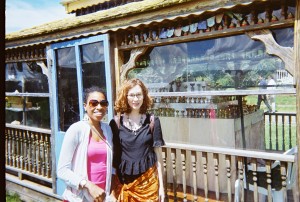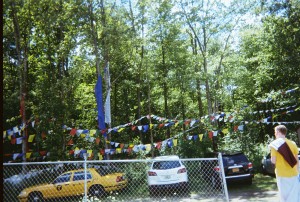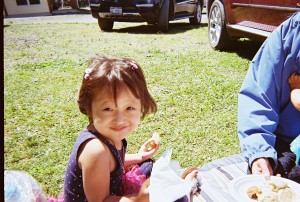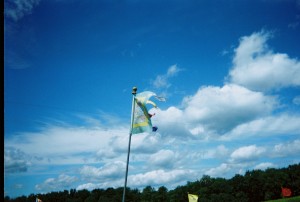The following entry was written by Visitor Experience Associate, Anne Brink.
Tibetans are known for crafting beautiful microcosms of their culture in just about any place outside their native Himalayas. There are many Tibetan Buddhist monasteries located in North America; one happens to be the Palyul Ling Retreat Center, tucked into a patch of serene woodlands just north of Binghamton, New York.
I had the opportunity to travel to Palyul Ling a few weeks ago with Tashi Chodron, Rubin Museum Educator and native Tibetan, for the center’s Limitless Light Long Life Empowerment ceremony, an annual summer retreat. The ceremony includes chants and long life offerings dedicated to all sentient beings everywhere. This year’s ceremony was led by His Holiness Karma Kuchen Rinpoche who is the lineage holder of Palyul Monastery.
Upon our arrival, we were met with an atmosphere of warmth and celebration. The center welcomes both Tibetans and non-Tibetans alike. Most of the other visitors were sitting on the grass outside the temple, eating homemade picnic lunches before the ceremony. Many had traveled by bus from Jackson Heights, Queens, where a large Tibetan community resides.
The Tibetan women wore beautiful long dresses called “chubhas.” Being my usual, unorganized self, I forgot to don a long skirt before meeting up with the group that morning, so had to borrow an orange scarf from Tashi to wrap around my black shorts before emerging from our van.
Tashi cooked a delicious meal for the occasion, one fit for Tibetan royalty: bhaley (a flatbread similar to naan), Aloo dhum ( potato curry), troe-pa (tripe!) and sho-soopen (a cilantro-yogurt-like hot sauce). Before the ceremony, I visited the butter lamp shelter with Evan Goodman, my Rubin Museum colleague, where hundreds of candles had been lit in honor of the ceremony. Inside, a slightly smoky smell emanated. Women prepared butter lamps to be lit and offered as prayers to the ancestors.
The Long Life ceremony is rooted in traditional empowerment practices of the Nyingma school. I sat behind a row of Buddhist retreat-goers, whose wooden tables were stacked with beautiful calligraphic texts. This empowerment ritual involved being given saffron-infused water to drink from our palms and small handfuls of dry white rice to toss forward during the mandala offering chants.
Saffron is considered to have sacred, cleansing qualities, while the rice is associated with a mandala offering. The tossing of rice is symbolic of thanking the lama (teacher) for bestowing this very special empowerment and also dedicating the merit accumulated to all sentient beings. This is consistent with Buddhist teachings that an individual blessing from a lama is not just about the single self; the real task is to unify this blessing with the greater good.
One of the most notable aspects of the ceremony were the traditional instruments— giant drums and golden horns played by musicians from the sides of the temple. Amidst the traditional dress, rituals and music were also marks of modern rituals: families snapping photos on their iPhones and iPads, capturing this special occasion.
After the ceremony, plastic bags of treats were handed out with fresh fruit and supermarket-style snacks like goldfish, beef jerky and Snickers. The attendees sat on the lawns and snacked while waiting for a lama dance to begin, performed by specially trained Buddhist monks. Tibetan Buddhists believe that the monks, dancing in a meditative state, balance spiritual energies, prevent negativity, and increase world peace. In addition to the regular dances, a snow lion dance was performed by Lama Ugen who is Tashi’s brother. This literal family connection seemed to be a metaphor for the entire atmosphere, which was familial and close, despite the hundreds of visitors.
Before leaving, I left a dollar for my favorite goddess, Tara, by her statue inside the temple. I also received a poster of the Tara’s manifestations to take back to New York City. She is now looking over a vase of flowers on my coffee table, a perfect reminder that Tibetan culture can continue to bloom in the smallest spaces, anywhere.
To experience similar works of art in context, feel free to visit the museum’s new Tibetan Shrine Room located in the Gateway To Himalayan Art exhibition at the Rubin Museum of Art. For more information on Palyul Ling, please visit: http://retreat.palyul.org/






